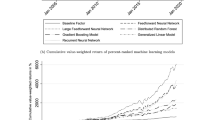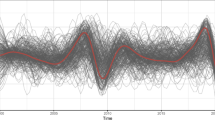Abstract
Although the analysis of dependence in financial markets started a century ago, there is still room for new work, both because statistical methods continue to de developed, allowing stronger and more robust analysis, and because more and more data is available. In this context, we propose to make a deep analysis of the Swiss stock market, one of the most important financial centres in the world, studying the main index and also 19 of its 20 components. We use detrended fluctuation analysis, which allows us to analyse the existence of long-term dependence in a given variable. As our objective is to analyse the evolution of that dependence over time, we use a sliding windows approach. The results show that several of the analysed stocks have a behaviour which is not consistent with the absence of dependence, which could be informative for actual and potential investors.








Similar content being viewed by others
Notes
It is usual, in this kind of analysis, to show the behaviour of the variation of stocks and returns. However, because this study has many indices, and due to space constraints, they are not shown, but are available upon request.
See the news in https://www.theguardian.com/business/2002/oct/23/12.
References
Anagnostidis P, Varsakelis C, Emmanouilides C (2016) Has the 2008 financial crisis affected stock market efficiency? The case of Eurozone. Phys A 447:116–128
Ausloos M (2000) Statistical physics in foreign exchange currency and stock markets. Phys A 285:48–65
Ausloos M, Vandewalle N, Boveroux P, Minguet A, Ivanova K (1999) Applications of statistical physics to economic and financial topics. Phys A 274:229–240
Ausloos M, Jovanovic F, Schinckus C (2016) On the “usual” misunderstandings between econophysics and finance: some clarifications on modelling approaches and efficient market hypothesis. Int Rev Financial Anal 47:7–14
Bachelier L (1900) Théorie de la spéculation. Annales Scientifiques de l’École Normale Supérieure 3(17):21–86
Barkoulas J, Baum C (1996) Long-term dependence in stock returns. Econ Lett 53:253–259
Bollerslev T, Jubinski D (1999) Equity trading volume and volatility: latent information arrivals and common long-run dependencies. J Bus Econ Stat 17:9–21
Breidt F, Crato N, Lima P (1993) Modeling long memory stochastic volatility. Working Paper of John Hopkins University, Baltimore
Cajueiro D, Tabak B (2004a) The Hurst exponent over time: testing the assertion that emerging markets are becoming more efficient. Phys A 336(3–4):521–537
Cajueiro D, Tabak B (2004b) Evidence of long range dependence in Asian equity markets: the role of liquidity and market restrictions. Phys A 342(3–4):656–664
Cajueiro D, Tabak B (2005) Ranking efficiency for emerging markets II. Chaos Solitons Fractals 23:671–675
Cajueiro D, Tabak B (2006) Testing for predictability in equity returns for European transition markets. Econ Syst 30(1):56–78
Cajueiro D, Tabak B (2007) Are the crude oil markets becoming weakly efficient over time? A test for time-varying long-range dependence in prices and volatility. Energy Econ 29:28–36
Cajueiro D, Tabak B (2008a) Testing for long-range dependence in world stock markets. Chaos Solitons Fractals 37(3):918–927
Cajueiro D, Tabak B (2008b) Testing for time-varying long-range dependence in real estate equity returns. Chaos Solitons Fractals 38(1):293–307
Campbell J, Grossman S, Wang J (1993) Trading volume and serial correlation in stock returns. Q J Econ 108:905–939
Cao G, Zhang M (2015) Extreme values in the Chinese and American stock markets based on detrended fluctuation analysis. Phys A 436(15):25–35
Carbone A, Castelli G, Stanley H (2004) Time dependent Hurst exponent in financial time series. Phys A 344:267–271
Christodoulou-Volosa C, Siokis F (2006) Long range dependence in stock market returns. Appl Financial Econ 16:1331–1338
Clark P (1973) A subordinated stochastic process model with finite variance for speculative prices. Econometrica 41:135–156
Cont R (2001) Empirical properties of asset returns: stylized facts and statistical issues. Quant Finance I:223–236
Cont R, Wagalath L (2013) Institutional investors and the dependence structure of asset returns. Int J Theor Appl Finance 19(2):1–37
Dajcman S (2012) Time-varying long-range dependence in stock market returns and financial market disruptions—a case of eight European countries. Appl Econ Lett 19:953–957
Di Matteo T, Aste T, Dacorogna M (2005) Long-term memories of developed and emerging markets: using the scaling analysis to characterize their stage of development. J Bank Finance 29(4):827–851
Ding Z, Granger C, Engle R (1993) A long memory property of stock market returns and a new model. J Empir Finance 1:83–106
Fama E (1963) Mandelbrot and the stable paretian hypothesis. J Bus 36(4):420–429
Fama E (1970) Efficient capital markets: a review of theory and empirical work. J Finance 25:383–417
Ferreira P (2016) Apple, alphabet or microsoft: which is the most efficient share? Econ Res Finance 1(2):67–79
Ferreira P, Dionísio A (2014) Revisiting serial dependence in the stock markets of the G7 countries, Portugal, Spain and Greece. Appl Financial Econ 24(5):319–331
Ferreira P, Dionísio A (2016a) G7 Stock markets: who is the first to defeat The DCCA correlation? Rev Soc Econ Perspect 1(1):107–120
Ferreira P, Dionísio A (2016b) How long is the memory of the US stock market? Phys A 451:502–506
Ferreira P, Loures L, Nunes J, Dionísio A (2017) The behaviour of share returns of football clubs: an econophysics approach. Phys A 472:136–144
Ferreira P, Dionísio A, Guedes E, Zebende G (2018) A sliding windows approach to analyse the evolution of bank shares in the European Union. Physica A 490:1355–1367
Gençay R, Gradojevic N (2010) Crash of ‘87—was it expected? Aggregate market fears and long-range dependence. J Empir Finance 17:270–282
Granger C, Morgenstern O (1964) Spectral analysis of New York Stock Market Prices. In: Cootner P (ed) The random character of stock Prices. MIT Press, Cambridge, originally published in 1963
Gvozdanovic I, Podobnik B, Wang D, Stanley E (2012) 1/f behavior in cross-correlations between absolute returns in a US market. Phys A 391:2860–2866
Herberger T, Kohlert D, Oehler A (2011) Momentum and industry-dependence: an analysis of the Swiss stock market. J Asset Manag 11(6):391–400
Hess M (2003a) What drives Markov regime-switching behavior of stock markets? The Swiss case. Int Rev Financial Anal 12:527–543
Hess M (2003b) Sector specific impacts of macroeconomic fundamentals on the Swiss stock market. Fin Mark Portf Manag 17(2):234–245
Isakov D (1999) Is beta still alive? Conclusive evidence from the Swiss stock market. Eur J Finance 5:202–212
Jochum C (1999) Volatility spillovers and the price of risk: evidence from the Swiss stock market. Empir Econ 24:303–322
Karanasos M, Kartsaklas A (2009) Dual long-memory, structural breaks and the link between turnover and the range-based volatility. J Empir Finance 16:838–851
Karpoff J (1987) The relation between price changes and trading volume: a survey. J Financial Quant Anal 22(1):109–126
Kendall M (1953) The analysis of economic time-series. J R Stat Soc 116:11–25
Kristoufek L (2014) Measuring cross-correlation between non-stationary series with DCCA coefficient. Phys A 402:291–298
Kristoufek L (2015) Detrended fluctuation analysis as a regression framework: estimating dependence at different scales. Phys Rev E 91:022802
Kumar M, Thenmozhi M (2012) Causal effect of volume on stock returns and conditional volatility in developed and emerging market. Am J Finance Account 2(4):346–362
Liu Y, Cizeau P, Meyer M, Peng C, Stanley H (1997) Correlations in economic time series. Phys A 245(3–4):437–440
Lobato I, Velasco C (2000) Long memory in stock-market trading volume. J Bus Econ Stat 18:410–427
López J, Contreras J (2013) Performance of multifractal detrended fluctuation analysis on short time series. Phys Rev E 87:022918
Mandelbrot B (1977) The fractal geometry of nature. Freeman and Company, New York
Osborne M (1964) Brownian motion in the stock prices. In: Cootner P (ed) The random character of stock prices. MIT Press, Cambridge, originally published in 1959
Parisi D, Sornett D, Helbing D (2013) Financial price dynamics and pedestrian counterflows: a comparison of statistical stylized facts. Phys Rev E 87:012804
Peng C, Buldyrev S, Havlin S, Simons M, Stanley E, Goldberger A (1994) Mosaic organization of DNA nucleotides. Phys Rev E 49:1685–1689
Pereira E, Silva M, Pereira H (2017) Econophysics: past and present. Phys A 473:251–261
Podobnik B, Stanley H (2008) Detrended cross-correlation analysis: a new method for analyzing two nonstationary time series. Phys Rev Lett 100:084102
Podobnik B, Horvatic D, Petersen A, Stanley E (2009) Cross-correlations between volume change and price change. Proc Natl Acad Sci USA 106:22079–22084
Podobnik B, Jiang Z, Zhou W, Stanley H (2011) Statistical tests for power-law cross-correlated processes. Phys Rev E 84:066118
Qian X, Liu Y, Jiang Z, Podobnik B, Zhou W, Stanley E (2015) Detrended partial cross-correlation analysis of two time series influenced by common external forces. Phys Rev E 91:062816
Ranaldo A (2001) Intraday market liquidity on the Swiss stock exchange. Financial Mark Portf Manag 15(3):309–327
Ray B, Tsay R (2000) Long-range dependence in daily stock volatilities. J Bus Econ Stat 18(2):254–262
Rey D, Schmid M (2007) Feasible momentum strategies: evidence from the Swiss stock market. Financial Mark Portf Manag 21:325–352
Sadique S, Silvapulle P (2001) Long-term memory in stock market returns: international evidence. Int J Financial Econ 6:59–67
Samuelson P (1965) Proof that properly anticipated prices fluctuate randomly. Ind Manag Rev 6:41–49
Sensoy A, Tabak B (2015) Time-varying long term memory in the European Union stock markets. Phys A 436(15):147–158
Sewell M (2011) History of the efficient market hypothesis. Research Note No. RN/11/04. UCL Department of Computer Science, London
Sibbersten P (2004) Long memory in volatilities of German stock returns. Empir Econ 29:477–488
Silva M, Pereira E, Filho A, Castro A, Miranda J, Zebende G (2015) Quantifying cross-correlation between Ibovespa and Brazilian blue-chips: the DCCA approach. Phys A 424:124–129
Ureche-Rangau L, Collado F, Galiay U (2011) The dynamics of the volatility—trading volume relationship: new evidence from developed and emerging markets. Econ Bull 31(3):2569–2583
Vandewalle N, Ausloos M (1997) Coherent and random sequences in financial fluctuations. Phys A 246(3–4):454–459
Wang Y, Wei Y, Wu C (2011a) Analysis of the efficiency and multifractality of gold markets based on multifractal detrended fluctuation analysis. Phys A 390(5):817–827
Wang Y, Wei Y, Wu C (2011b) Detrended fluctuation analysis on spot and futures markets of West Texas Intermediate crude oil. Phys A 390(5):864–875
Zebende G (2011) DCCA cross-correlation coefficient: quantifying level of cross-correlation. Phys A 390(4):614–618
Acknowledgements
This work was funded by Fundação para a Ciência e a Tecnologia (Grant UID/ECO/04007/2013) and FEDER/COMPETE (POCI-01-0145-FEDER-007659).
Author information
Authors and Affiliations
Corresponding author
Ethics declarations
Conflict of interest
The author declares that he has no conflict of interest.
Ethical approval
This article does not contain any studies with human participants or animals performed by any of the authors.
Rights and permissions
About this article
Cite this article
Ferreira, P. Dynamic long-range dependences in the Swiss stock market. Empir Econ 58, 1541–1573 (2020). https://doi.org/10.1007/s00181-018-1549-x
Received:
Accepted:
Published:
Issue Date:
DOI: https://doi.org/10.1007/s00181-018-1549-x
















